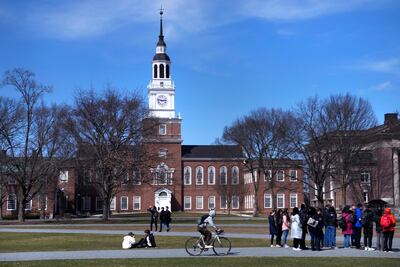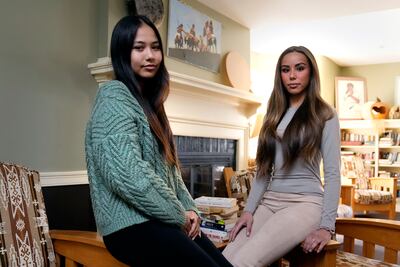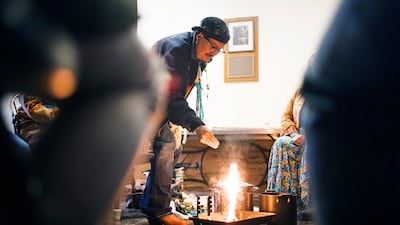As a citizen of the Quapaw Nation, Ahnili Johnson-Jennings has always seen Dartmouth College in Hanover, New Hampshire, as the university for Native American students.
Her father graduated from the institution, founded in 1769 to educate Native Americans, and she had come to rely on its network of students, professors and administrators. But news in March that the Ivy League university found partial skeletal remains of 15 Native Americans in one of its collections has Johnson-Jennings and others reassessing that relationship.
“It’s hard to reconcile. It’s hard to see the college in this old way where they were taking Native remains and using them for their own benefit,” says Johnson-Jennings, a senior and co-president of Native Americans at Dartmouth. The remains were used to teach a class as recently as last year, just before an audit concluded they had been wrongly catalogued as not Native.
“It was very upsetting to hear, especially when you’ve just felt so supported by a school and they’ve had that secret that maybe no one knew about, but still, to some sense, was a secret,” she says, describing a March meeting where Native American students were briefed on the discovery.
Dartmouth is among a growing list of universities, museums and other institutions trying to figure out how best to handle Native American remains and artefacts in their collections and grappling with what these discoveries say about their past policies regarding Native communities.
Until the 20th century, archeologists, anthropologists, collectors and curiosity seekers took Native remains and sacred objects during expeditions on tribal lands. Some remains, including Native skulls, were sought after in the name of science, while bodies were collected by government agencies after battles with tribes. Museums wanted them to enhance their collections, while academic institutions came to rely on Native bones as teaching tools.
“One hundred years ago, it was OK for a professor, for an alumni to go into the lands of a Native community and dig up their ancestors,” says professor Jeremy DeSilva, a paleoanthropologist and chairman of Dartmouth’s anthropology department.
He continues: “It’s amazing that folks didn’t recognise how harmful that was.”

For Native tribes, the loss of the remains and cultural items caused significant pain. The remains, most believe, are imbued with the spirit of the ancestor to whom they belong and are connected to living citizens of those tribes. They could go to court or negotiate with an institution for them to be repatriated. But it wasn’t until the Native American Graves Protection and Repatriation Act in 1990 that a process was created for their return.
It requires federally funded institutions, including universities, to return remains and funerary items to rightful communities. In February, Cornell University returned ancestral remains to the Oneida Indian Nation that were inadvertently dug up in 1964 and stored for decades in the institution's archive. Colgate University in November returned to the Oneidas more than 1,500 items once buried with ancestral remains, some dating back 400 years. And since 1995, Dartmouth itself has repatriated skeletal remains of 10 Native Americans along with 36 burial objects.
Critics complain that many institutions move too slowly in repatriating remains and funerary items once they’re discovered in their collections, often hiding behind a loophole in Nagpra that allows them to label remains as culturally unidentifiable. That puts the burden on tribes to prove the remains are their ancestors, an expense many can’t afford.
About 884,000 Native American artefacts — including nearly 102,000 human remains — that should be returned to tribes under federal law, are still in the possession of colleges, museums and other institutions across the country, according to data maintained by the National Park Service.
The University of California, Berkeley tops the list, according to the Park Service, followed closely by the Ohio History Connection, a non-profit organisation working to preserve the state's history and Harvard University's Peabody Museum of Archaeology and Ethnology.
Shannon O’Loughlin, chief executive of the Association on American Indian Affairs, a national group that assists tribes with repatriations, called the practice racist.
“It just says that they value the idea of Native Americans as specimens more than they do as human beings,” says O’Loughlin, a citizen of the Choctaw Nation of Oklahoma.
The most recent discovery at Dartmouth has set off the complex and complicated process of returning the remains to the affiliated tribes.
The remains, in its teaching collection in Silsby Hall, were discovered in November, following an audit spearheaded by Jami Powell, curator of Indigenous art at Dartmouth’s Hood Museum.
Until they were found to be Native, the bones had been stored in a locked cabinet in the basement. They have since been moved to a secure off-campus location and Dartmouth has hired a team of independent experts to study them and do archival research to determine their origin. The college says the review will take months.

It also is studying an additional 100 bones that may be Native American and working with tribes to repatriate additional bone fragments related to three individuals that were repatriated in the 1990s.
“For me as an Indigenous person, it’s always important in my work that I treat these ancestors with the utmost care and respect and that an essential part of my function is helping them return home,” Powell says.
In March, Dartmouth president Philip Hanlon said he was “deeply saddened by what we’ve found on our campus” and apologised for the college’s wrongful possession of the remains. He pledged “to take careful and meaningful action to address our situation and consult with the communities most directly impacted".
The Department of Anthropology’s teaching collection is believed to come from several sources — bones purchased from biological supply companies; donated cadavers used by medical students; and archeological remains, some of which came from Native American burial mounds and were given by alumni. Until November, Dartmouth officials say they believed Native American bones had been removed from the school in the 1990s.
“Nobody had really taken the time or the effort to fully document what we had. This was around a time where our whole discipline was beginning to reflect a little more deeply on what it meant to be in the care of, or caring for human remains,” says DeSilva, the anthropology department’s chairman.
DeSilva acknowledged mistakes in documenting Native American remains, but says they weren’t malicious and that although no one was to blame, he hopes the most recent discovery will force a reckoning over past practices.
Along with working to return the Native American remains, the college is re-evaluating its whole collection of human remains and plans to “build an ethically sourced collection that complies with legal standards” to be used in osteology — the study of bones and skeletal systems.
The college is also working to repair the relationship with Native students and alumni, starting with a March meeting in which Hanlon apologised. The institution also worked to accommodate Native students who were uncomfortable going into Silsby. Many Native Americans believe it is taboo to speak about the dead or be near them.
Last month, a Navajo medicine man held a cleansing ceremony at several locations on campus, including Silsby.
The discovery has spotlighted Dartmouth’s relationship with its Native students, who represent about one per cent of the 4,458 students. Though the school was formed to teach Native students, it wasn’t until 1972 that the college created one of the first Native programs in the country. Still, the college has had to confront symbols of insensitivity that lingered on campus, including in 2018, when it announced it would move into storage a set of murals that offended Native Americans.
Shawn Attakai, co-president of the Native American Alumni Association of Dartmouth, says he is disappointed about the discovery and sad about the possibility that they could be from his own Navajo Nation, where he is a tribal lawyer. But Attakai also says he is not surprised.
“Native Americans have a history of injustices in this country starting from it’s founding all the way to the present,” he says.
Johnson-Jennings appreciates the efforts, but says justice requires a person or entity to be held accountable for the remains having been mislabeled for so long.
“It was disappointing that it went on for so long and does feel a little bit sad that the college was not able to find that mistake and find out that they were mislabeled before,” she says. “That’s a mistake that us Natives are paying for, the tribes that those ancestors belong to are paying for.”


